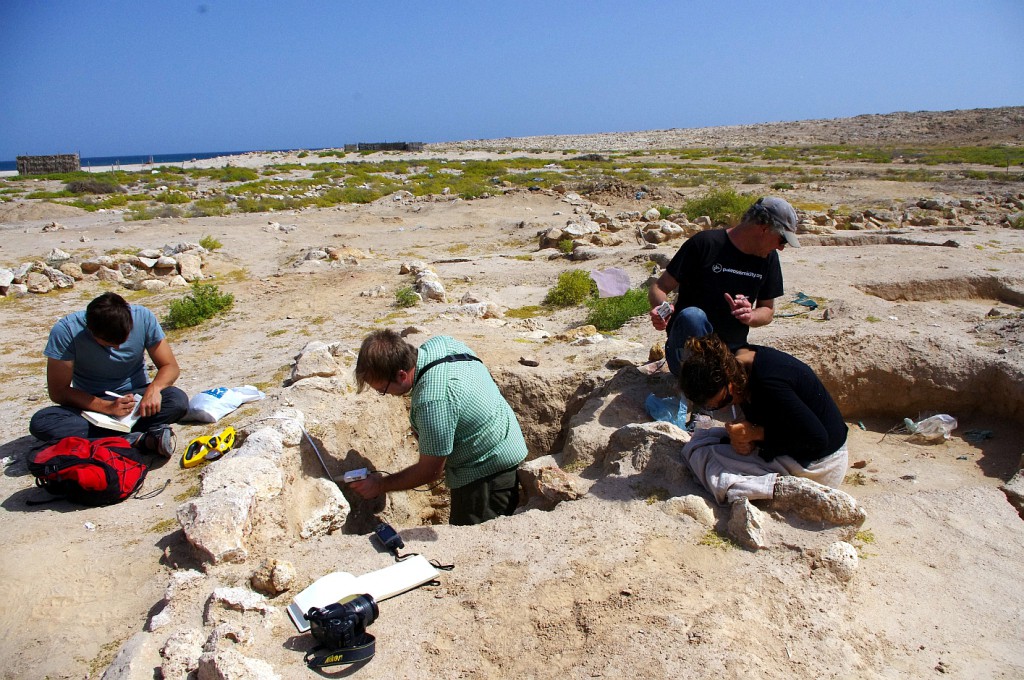Klaus, Ben, Sascha and me went to visit our colleague Gösta at the GUtech in the Sultanate of Oman. We did some fieldwork for our project which deals with coastal changes. Parts of the Omani coast subside, others appear to be stable or are even uplifted. This might be due to large scaled crustal movements (the Makran Subduction zone is nearby) and/or regional effects. We are trying to find good proxies for reconstructing the Holocene sealevel and climate changes. Additionally, we need to get a grip on the neotectonics that affect the coastal areas. The Omani coast has been hit by two tropical storms recently, Gonu (June 2007) and Phet (June 2010).You can still see the devastation they left. Many roads are still damaged or blocked, houses needed to be abandoned and the Wadis are full of debris. Additionally, there are hints for tsunamis that reached the coast of the Sultanate (Hoffmann et al., 2011: Evidence for Holocene tsunami-impact along the shoreline of Oman. PDF).
Our working area was the northern and north-eastern coast of the Sultanate – terraces, lagoons, beach walls, beaches, archaeological sites. Of course, as neotectonic guys we always had a look at faults.
We did some drillings to find out about tsunamites and tempestites and opened several pits to check the sediments.
We also did a lot of ground penetrating radar and magnetic susceptibility measurements to find out about the geophysical parameters of our deposits.
All in all we felt this field trip was successful. We found very interesting and promising new sites in the eastern parts of the coast and recorded tons of data. All the mapping filled dozens of pages in my field book.
To get an idea about our geological field work, I’ve prepared a little video:
What’s your field work like? Post videos!
Read more:
- Hoffmann, G., Reicherter, K., Wiatr, T., Grützner, C., 2012. Short- and longterm environmental changes along the coastline of Oman (Arabian Peninsula). International Conference on the Geology of the Arabian Plate and the Oman Mountains, 7-9th January, 2012, Sultan Qaboos University, Muscat, Sultanate of Oman.
- Hoffmann, G., Reicherter, K., Wiatr, T., Grützner, C., 2011. Evidence for Holocene tsunami-impact along the shoreline of Oman. In: Grützner, C., Fernández Steeger, T., Papanikolaou, I., Reicherter, K., Silva, P.G., Pérez-López, R., Vött, A. (eds.): Proceedings 2nd INQUA-IGCP567 International Workshop on Active Tectonics, Earthquake Geology, Archaeology and Engineering 19-24 September 2011, Corinth (Greece), ISBN: 978-960-466-093-3, 88-91. (download)
- Hoffmann, G., Grützner, C., Reicherter, K., 2010. Past and present coastal dynamics of the Sultanate Oman (Arabian Peninsula) – tectonic versus sea-level forcing. – IGCP 588/INQUA coastal and marine processes commission. – The University of Hongkong; 30.11-04.12.2010.
- Hoffmann, G., Gruetzner, C., Reicherter, K., 2010. Coastal evolution of the Sultanate Oman (Arabian Peninsula) – tectonic versus sea-level forcing. EGU General Assembly 2010, Vienna, EGU2010-6201. (download abstract)









No Comments
No comments yet.